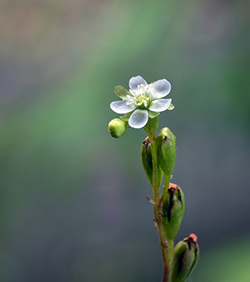The sundew plant once amazed two would-be scientists when they saw a mosquito caught in its leaves. While both men witnessed the curious phenomenon, the mosquito began to disappear due to the action of a digestive enzyme, similar to our gastric juice, which the sundew leaves secrete. This carnivorous plant can capture and digest around 2000 insects in one summer.
- Trap Structure: Sundews have specialized leaves covered with glandular hairs that secrete a sticky substance. The sticky droplets resemble dew, giving the plant its name. These droplets attract and ensnare insects that come into contact with them.
- Flowers: Sundews produce small, delicate flowers on stalks that rise above the leaves. The flowers can vary in color and appearance depending on the species. The flowers are typically insect-pollinated, and once fertilized, they produce seeds for propagation.

Sundew Plant Scientific Facts
- Scientific name: Drosera rotundifolia L.
- French: Dosera.
- Spanish: Drosera.
- Environment: Rare species that usually grow in humid mountain soils. Naturalized to America.
- Description: This is a vibrant small plant of the Droseraceae family, growing not more than 15 cm high. The leaves grow at ground level, forming a rose, and are covered with sticky hairs to which insects stick.
- Parts of the plant used medicinally: The aerial part of the plant.

Healing Properties and Indications
The entire sundew plant contains naphthoquinones, the most important of which is plumbagin, which gives it antitussive, bechic, antibiotic, and antispasmodic properties. It has been proven effective against streptococcus, staphylococcus, and pneumococcus.

Because of this, it is an excellent remedy against dry, irritated coughs caused by pharyngitis, laryngitis, or tracheitis. It is highly recommended for whooping cough and asthma. For acute, chronic bronchitis, sundew eases cough and promotes expectoration.
How to use Sundew
- Infusion 15-20 g of plant per liter of water. Drink four or five cups daily.
- Tincture. It is helpful for children in a dose of five drops per year, taking up to 30 drops daily throughout the day. Administer dissolved into water or fruit juice.
Frequently Asked Question
What are the traditional and historical uses of the sundew plant?
Sundew has a long history of use in folk medicine. Primarily, it was employed for respiratory conditions like coughs, bronchitis, and even whooping cough. It was also used as a topical treatment for skin ailments like warts.
Is scientific research backing up any of the sundew plant’s health claims?
Yes, some promising studies exist. While more research is always needed, early investigations indicate that sundew extracts have antispasmodic properties that may be helpful for coughs.
What forms of the sundew plant are used medicinally?
Dried sundew herbs can be made into teas, tinctures, and syrups. Standardized sundew extracts are also available in capsule form.
Are there potential drug interactions with sundew?
It’s crucial to consult a doctor before taking any herbs, especially if you’re on medications. Sundew’s interactions with pharmaceuticals haven’t been extensively studied, so caution is advised.
Is the sundew plant safe for everyone?
Sundew is generally considered safe for most adults when used in appropriate doses for short-term purposes. However, as safety information is lacking, pregnant and breastfeeding women should avoid it. It’s also unsuitable for children without close medical supervision.
Can sundew interact with conditions like diabetes?
Limited evidence suggests that sundew could lower blood sugar levels. If this is the case, those with diabetes should closely monitor their levels.
Where can I obtain high-quality sundew products?
Purchasing from reputable herbal suppliers specializing in medicinal plants is essential. Look for well-established companies with precise sourcing and quality control practices. A consultation with a qualified herbalist is beneficial for personalized guidance.
What’s the typical dosage of the sundew plant?
The dosage depends on the preparation form (tea, tincture, etc.) and the specific sundew species used. It is essential to follow the directions on a product label or work with an herbalist for appropriate dosing.
Are there side effects associated with sundew?
Sundew is usually well-tolerated, but it can cause mild digestive upset for some individuals. Very rarely, allergic reactions might occur.
Can sundew replace conventional medical treatment?
No. While sundew may be a helpful complementary therapy for certain conditions, it should never replace proven medical treatments prescribed by a doctor. To arrive at a correct diagnosis and devise a treatment strategy, conferring with a certified medical practitioner is necessary.
- Sundew tincture contains ONLY natural ingredients!
- High Quality Sundew liquid extract- crude extract of first extraction! We meticulously produce our extracts according to precise standards where each herb is extracted according to the distinct characteristic of each plant!
- Super concentrated Sundew extract: dry material / menstruum ratio 1:3!
DISCLAIMER: All content on this website is presented solely for educational and informational objectives. Do not rely on the information provided as a replacement for advice, diagnosis, or treatment from a qualified medical expert. If you are pregnant, nursing, or have any preexisting medical concerns, talk to your doctor before using any herbal or natural medicines.
REFERENCES
- George D. Pamplona-Roger, M.D. “Encyclopedia of Medicinal Plants.” George D. Pamplona-Roger, M.D. Encyclopedia of Medicinal Plants. Ed. Francesc X. Gelabert. vols. 2 San Fernando de Henares: Editorial Safeliz, 2000. 754. Print.[Sundew plant]
- WebMD https://www.webmd.com/vitamins/ai/ingredientmono-386/sundew
- National Institutes of Health https://www.ncbi.nlm.nih.gov/pmc/articles/PMC7250096/
- Journal of Ethnopharmacology https://www.sciencedirect.com/science/article/abs/pii/S037887411100458X
Last update on 2024-04-24 / Affiliate links / Images from Amazon Product Advertising API


